A Review on Battery Charging and Discharging Control Strategies: Application to Renewable Energy Systems
Abstract
1. Introduction
2. Traditional Charging Control Methods
2.1. Constant Current (CC)
2.2. Constant Voltage (CV)
2.3. Constant Current–Constant Voltage (CC–CV)
2.4. Pulse Charging (PC)
2.5. Reflex Charging or Negative Pulse Charging (NPC)
2.6. Trickle Charge or Taper-Current (TC)
2.7. Float Charge (FC)
3. Battery Management Systems
3.1. Fuzzy Logic Control (FLC)
3.1.1. Fuzzy Logic Control of Energy Storage Systems in Stand-Alone Applications
3.1.2. Fuzzy Logic Control of Energy Storage Systems in Grid-Connected Applications
3.2. Model Predictive Control (MPC)
3.2.1. Model Predictive Control of Energy Storage Systems in Stand-Alone Applications
3.2.2. Model Predictive Control of Energy Storage Systems in Grid-Connected Applications
4. Results and Discussion
5. Conclusions and Future Work
Acknowledgments
Author Contributions
Conflicts of Interest
Appendix A
Appendix A.1. FLC Applied to PV Systems with BESS
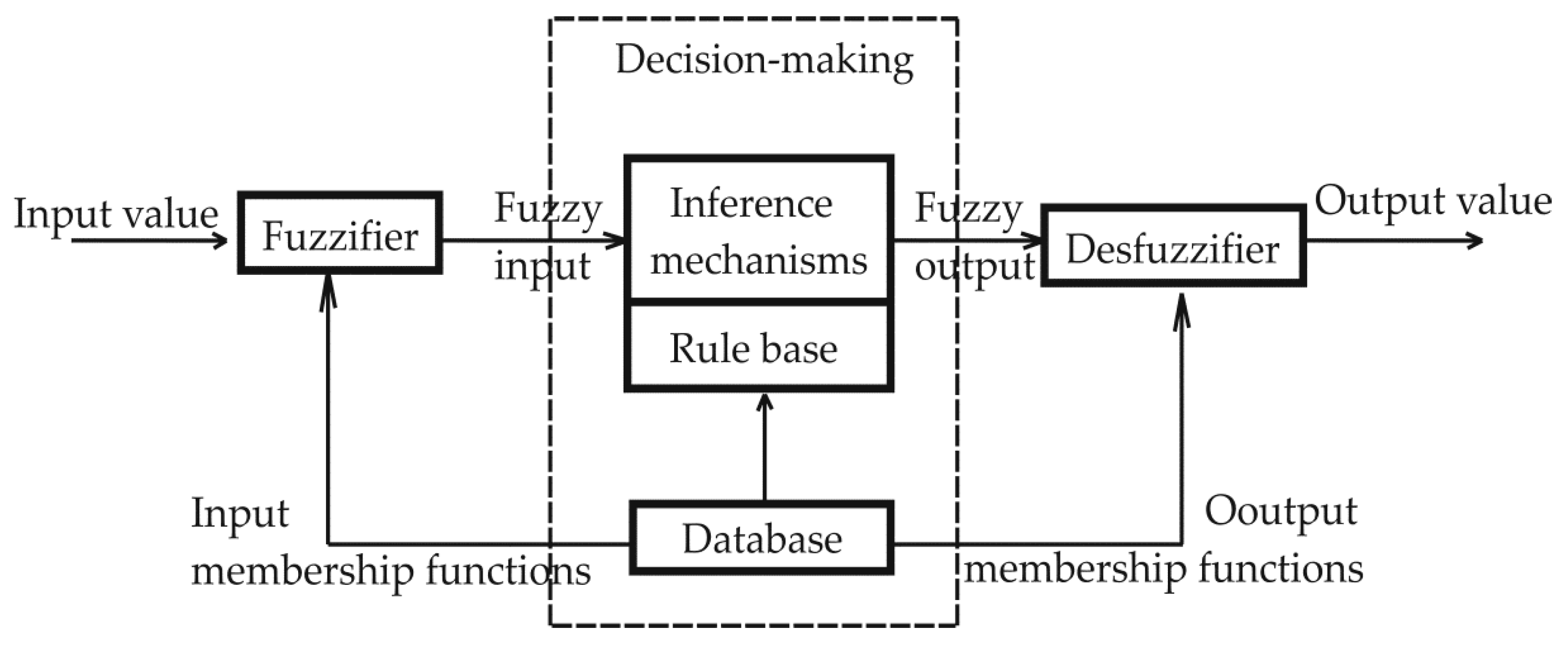
Appendix A.2. MPC Applied to PV Systems with BESS

References
- Khalilpour, R.; Vassallo, A. Planning and operation scheduling of PV-battery systems: A novel methodology. Renew. Sustain. Energy Rev. 2016, 53, 194–208. [Google Scholar] [CrossRef]
- Yang, Z.; Zhang, J.; Kintner-Meyer, M.C.; Lu, X.; Choi, D.; Lemmon, J.P.; Liu, J. Electrochemical energy storage for green grid. Chem. Rev. 2011, 111, 3577–3613. [Google Scholar] [CrossRef] [PubMed]
- Bamgbopa, M.O.; Almheiri, S.; Sun, H. Prospects of recently developed membraneless cell designs for redox flow batteries. Renew. Sustain. Energy Rev. 2017, 70, 506–518. [Google Scholar] [CrossRef]
- Sayigh, A. (Ed.) Renewable Energy in the Service of Mankind Vol I: Selected Topics from the World Renewable Energy Congress WREC 2014; Springer: Berlin, Germany, 2015. [Google Scholar]
- Armstrong, S.; Glavin, M.E.; Hurley, W.G. Comparison of battery charging algorithms for stand-alone photovoltaic systems. In Proceedings of the 2008 Power Electronics Specialists Conference (PESC 2008), Rhodes, Greece, 15–19 June 2008; pp. 1469–1475. [Google Scholar]
- Koohi-Kamali, S.; Tyagi, V.V.; Rahim, N.A.; Panwar, N.L.; Mokhlis, H. Emergence of energy storage technologies as the solution for reliable operation of smart power systems: A review. Renew. Sustain. Energy Rev. 2013, 25, 135–165. [Google Scholar] [CrossRef]
- Kousksou, T.; Bruel, P.; Jamil, A.; El Rhafiki, T.; Zeraouli, Y. Energy storage: Applications and challenges. Sol. Energy Mater. Sol. Cells 2014, 120, 59–80. [Google Scholar] [CrossRef]
- Akinyele, D.; Belikov, J.; Levron, Y. Battery Storage Technologies for Electrical Applications: Impact in Stand-Alone Photovoltaic Systems. Energies 2017, 10, 1760. [Google Scholar] [CrossRef]
- Kaldellis, J.K.; Zafirakis, D.; Kavadias, K. Techno-economic comparison of energy storage systems for island autonomous electrical networks. Renew. Sustain. Energy Rev. 2009, 13, 378–392. [Google Scholar] [CrossRef]
- Ferreira, H.L.; Garde, R.; Fulli, G.; Kling, W.; Lopes, J.P. Characterization of electrical energy storage technologies. Energy 2013, 53, 288–298. [Google Scholar] [CrossRef]
- Chen, H.; Cong, T.N.; Yang, W.; Tan, C.; Li, Y.; Ding, Y. Progress in electrical energy storage system: A critical review. Prog. Nat. Sci. 2009, 19, 291–312. [Google Scholar] [CrossRef]
- Díaz-González, F.; Sumper, A.; Gomis-Bellmunt, O.; Villafáfila-Robles, R. A review of energy storage technologies for wind power applications. Renew. Sustain. Energy Rev. 2012, 16, 2154–2171. [Google Scholar] [CrossRef]
- Evans, A.; Strezov, V.; Evans, T.J. Assessment of utility energy storage options for increased renewable energy penetration. Renew. Sustain. Energy Rev. 2012, 16, 4141–4147. [Google Scholar] [CrossRef]
- Sedighnejad, H.; IqbaL, T.; Quaicoe, J. Compressed air energy storage system control and performance assessment using energy harvested index. Electronics 2014, 3, 1–21. [Google Scholar] [CrossRef]
- Alotto, P.; Guarnieri, M.; Moro, F. Redox flow batteries for the storage of renewable energy: A review. Renew. Sustain. Energy Rev. 2014, 29, 325–335. [Google Scholar] [CrossRef]
- Nikdel, M. Various battery models for various simulation studies and applications. Renew. Sustain. Energy Rev. 2014, 32, 477–485. [Google Scholar]
- Hoppmann, J.; Volland, J.; Schmidt, T.S.; Hoffmann, V.H. The economic viability of battery storage for residential solar photovoltaic systems—A review and a simulation model. Renew. Sustain. Energy Rev. 2014, 39, 1101–1118. [Google Scholar] [CrossRef]
- Hesse, H.C.; Martins, R.; Musilek, P.; Naumann, M.; Truong, C.N.; Jossen, A. Economic optimization of component sizing for residential battery storage systems. Energies 2017, 10, 835. [Google Scholar] [CrossRef]
- Fathima, H.; Palanisamy, K. Optimized sizing, selection, and economic analysis of battery energy storage for grid-connected wind-PV hybrid system. Model. Simul. Eng. 2015, 2015, 16. [Google Scholar] [CrossRef]
- Battke, B.; Schmidt, T.S.; Grosspietsch, D.; Hoffmann, V.H. A review and probabilistic model of lifecycle costs of stationary batteries in multiple applications. Renew. Sustain. Energy Rev. 2013, 25, 240–250. [Google Scholar] [CrossRef]
- Luo, X.; Wang, J.; Dooner, M.; Clarke, J. Overview of current development in electrical energy storage technologies and the application potential in power system operation. Appl. Energy 2015, 137, 511–536. [Google Scholar] [CrossRef]
- Dekka, A.; Ghaffari, R.; Venkatesh, B.; Wu, B. A survey on energy storage technologies in power systems. In Proceedings of the Electrical Power and Energy Conference (EPEC), London, ON, Canada, 26–28 October 2015; pp. 105–111. [Google Scholar]
- Hsieh, H.-I.; Tsai, C.-Y.; Hsieh, G.-C. Photovoltaic burp charge system on energy-saving configuration by smart charge management. IEEE Trans. Power Electron. 2014, 29, 1777–1790. [Google Scholar] [CrossRef]
- Yin, Y.; Luo, X.; Guo, S.; Zhou, Z.; Wang, J. A battery charging control strategy for renewable energy generation systems. In Proceedings of the World Congress on Engineering, London, UK, 2–4 July 2008; pp. 2–4. [Google Scholar]
- Dakkak, M.; Hasan, A. A charge controller based on microcontroller in stand-alone photovoltaic systems. Energy Procedia 2012, 19, 87–90. [Google Scholar] [CrossRef][Green Version]
- Eldahab, Y.E.A.; Saad, N.H.; Zekry, A. Enhancing the design of battery charging controllers for photovoltaic systems. Renew. Sustain. Energy Rev. 2016, 58, 646–655. [Google Scholar] [CrossRef]
- Bandara, G.; Ivanov, R.; Gishin, S. Intelligent fuzzy controller for a lead-acid battery charger. In Proceedings of the 1999 IEEE International Conference on Systems, Man, and Cybernetics (SMC’99), Tokyo, Japan, 12–15 October 1999; pp. 185–189. [Google Scholar]
- Hua, C.-C.; Lin, M.-Y. A study of charging control of lead-acid battery for electric vehicles. In Proceedings of the 2000 IEEE International Symposium on Industrial Electronics (ISIE 2000), Cholula, Puebla, Mexico, 4–8 December 2000; pp. 135–140. [Google Scholar]
- Ayoub, E.; Karami, N. Review on the charging techniques of a li-ion battery. In Proceedings of the Third International Conference on Technological Advances in Electrical, Electronics and Computer Engineering (TAEECE), Beirut, Lebanon, 29 April–1 May 2015; pp. 50–55. [Google Scholar]
- Rand, D.A.J.; Moseley, P.T.; Rand, D.A.J.; Moseley, P.T.; Garche, J.; Parker, C.D. Valve Regulated Lead Acid Batteries; Elsevier: New York, NY, USA, 2004; ISBN 0-4445-0746-9. [Google Scholar]
- Lin, F.J.; Huang, M.S.; Yeh, P.Y.; Tsai, H.C.; Kuan, C.H. DSP-based probabilistic fuzzy neural network control for Li-ion battery charger. IEEE Trans. Power Electron. 2012, 27, 3782–3794. [Google Scholar] [CrossRef]
- Hua, A.C.-C.; Syue, B.Z.-W. Charge and discharge characteristics of lead-acid battery and LiFePO4 battery. In Proceedings of the IEEE 2010 International Power Electronics Conference (IPEC), Sapporo, Japan, 21–24 June 2010; pp. 1478–1483. [Google Scholar]
- Lee, C.S.; Lin, H.C.; Lai, S.-Y. Development of fast large lead-acid battery charging system using multi-state strategy. Int. J. Comput. Consum. Control 2013, 2, 56–65. [Google Scholar]
- Lin, H.C.; He, Y.J.; Liu, C.W. Design of an Efficient Battery Charging System Based on Ideal Multi-State Strategy. In Proceedings of the IEEE 2016 International Symposium on Computer, Consumer and Control (IS3C), Xi’an, China, 4–6 July 2016; pp. 956–959. [Google Scholar]
- Yan, J.; Xu, G.; Qian, H.; Xu, Y.; Song, Z. Model predictive control-based fast charging for vehicular batteries. Energies 2011, 4, 1178–1196. [Google Scholar] [CrossRef]
- Wong, Y.S.; Hurley, W.G.; Wölfle, W.H. Charge regimes for valve-regulated lead-acid batteries: Performance overview inclusive of temperature compensation. J. Power Sources 2008, 183, 783–791. [Google Scholar] [CrossRef]
- Rossinot, E.; Lefrou, C.; Dalard, F.; Cun, J.P. Batteries in standby applications: Comparison of alternate mode versus floating. J. Power Sources 2001, 101, 27–34. [Google Scholar] [CrossRef]
- Chen, L.-R. Design of duty-varied voltage pulse charger for improving Li-ion battery-charging response. IEEE Trans. Ind. Electron. 2009, 56, 480–487. [Google Scholar] [CrossRef]
- Liu, C.L.; Chiu, Y.S.; Liu, Y.H.; Ho, Y.H.; Huang, S.S. Optimization of a fuzzy-logic-control-based five-stage battery charger using a fuzzy-based taguchi method. Energies 2013, 6, 3528–3547. [Google Scholar] [CrossRef]
- Huang, S.-J.; Huang, B.-G.; Pai, F.-S. Fast Charge Strategy Based on the Characterization and Evaluation of LiFePO4 Batteries. IEEE Trans. Power Electron. 2013, 28, 1555–1562. [Google Scholar] [CrossRef]
- Liu, Y.-H.; Teng, J.-H. Design and implementation of a fully-digital Lithium-Ion battery charger. In Proceedings of the 2006 IEEE Region 10 Conference (TENCON 2006), Hongkong, China, 14–17 November 2006; pp. 1–4. [Google Scholar]
- Linden, D.; Reddy, T.B. Handbook of Batteries, 3rd ed.; McGraw Hill: New York, NY, USA, 2002. [Google Scholar]
- Nasser, K. Negative Pulse Charging: Myths and Facts. Available online: http://www.batterypoweronline.com/images/PDFs_articles_whitepaper_appros/powerdesigners.pdf (accessed on 3 May 2017).
- Li, S.; Zhang, C.; Xie, S. Research on fast charge method for lead-acid electric vehicle batteries. In Proceedings of the IEEE International Workshop on Intelligent Systems and Applications ISA 2009, Wuhan, China, 23–24 May 2009; pp. 1–5. [Google Scholar]
- James, M.; Grummett, J.; Rowan, M.; Newman, J. Application of pulse charging techniques to submarine lead-acid batteries. J. Power Sources 2006, 162, 878–883. [Google Scholar] [CrossRef]
- Battery Application & Technology. Available online: https://www.engineersedge.com/battery/trickle_charging.htm (accessed on 5 April 2018).
- Chuang, Y.C.; Ke, Y.L.; Chuang, H.S.; Chang, S.Y. Battery float charge technique using parallel-loaded resonant converter for discontinuous conduction operation. IEEE Trans. Ind. Appl. 2012, 48, 1070–1078. [Google Scholar] [CrossRef]
- Battery Charging Methods. Available online: http://www1.labvolt.com/publications/Exercises/86351-00_4.pdf (accessed on 5 April 2018).
- Battery Management of the SunnyIsland. Available online: http://files.sma.de/dl/7910/SI_Batteriemanagement-TI-en-21.pdf (accessed on 22 June 2017).
- Zadeh, L.A. Fuzzy sets. Inf. Control 1965, 8, 338–353. [Google Scholar] [CrossRef]
- Hsieh, G.-C.; Chen, L.-R.; Huang, K.-S. Fuzzy-controlled Li-ion battery charge system with active state-of-charge controller. IEEE Trans. Ind. Electron. 2001, 48, 585–593. [Google Scholar] [CrossRef]
- Precup, R.-E.; Hellendoorn, H. A survey on industrial applications of fuzzy control. Comput. Ind. 2011, 62, 213–226. [Google Scholar] [CrossRef]
- Liu, C.-L.; Chen, J.-H.; Liu, Y.H.; Yang, Z.-Z. An asymmetrical fuzzy-logic-control-based MPPT algorithm for photovoltaic systems. Energies 2014, 7, 2177–2193. [Google Scholar] [CrossRef]
- Gdaim, S.; Mtibaa, A.; Mimouni, M.F. Design and experimental implementation of DTC of an induction machine based on fuzzy logic control on FPGA. IEEE Trans. Fuzzy Syst. 2015, 23, 644–655. [Google Scholar] [CrossRef]
- Bago, J.C.; Galán, S.G.; Aguilera, J.; Velasco, J.R.; Magdalena, L. Fuzzy controller applications in stand-alone photovoltaic systems. Mathw. Soft Comput. 2008, 9, 85–105. [Google Scholar]
- Rahim, N.A.; Mekhilef, S.; Chan, E.L.; Ping, H.W. Fuzzy-controlled battery charger state-of-charge controller. Int. J. Model. Simul. 2006, 26, 106–111. [Google Scholar] [CrossRef]
- Huang, C.H.; Huang, C.C.; Ou, T.C.; Lu, K.H.; Hong, C.M. Intelligent fuzzy logic controller for a solar charging system. In Proceedings of the IEEE/ASME International Conference on Advanced Intelligent Mechatronics (AIM 2009), Singapore, 14–17 July 2009; pp. 1412–1417. [Google Scholar]
- Yarn, K.F.; Wu, K.K.; Chung, L.Y. Fuzzy logic control of Photovoltaic Lead-Acid Charging System. Adv. Mater. Res. 2011, 219–220, 941–944. [Google Scholar] [CrossRef]
- Kim, J.Y.; Kim, H.M.; Kim, S.K.; Jeon, J.H.; Choi, H.K. Designing an energy storage system fuzzy PID controller for microgrid islanded operation. Energies 2011, 4, 1443–1460. [Google Scholar] [CrossRef]
- Zhao, H.; Wu, Q.; Wang, C.; Cheng, L.; Rasmussen, C.N. Fuzzy logic based coordinated control of battery energy storage system and dispatchable distributed generation for microgrid. J. Mod. Power Syst. Clean Energy 2015, 3, 422–428. [Google Scholar] [CrossRef]
- Welch, R.L.; Venayagamoorthy, G.K. Energy dispatch fuzzy controller for a grid-independent photovoltaic system. Energy Convers. Manag. 2010, 51, 928–937. [Google Scholar] [CrossRef]
- Welch, R.L.; Venayagamoorthy, G.K. Comparison of two optimal control strategies for a grid independent photovoltaic system. In Proceedings of the Conference Record of the 2006 IEEE 41st IAS Annual Meeting Industry Applications Conference, Tampa, FL, USA, 8–12 October 2006; pp. 1120–1127. [Google Scholar]
- Wang, F.-S.; Suo, X.-S. Research on Batterys charging system based on the Fuzzy control. In Proceedings of the 2nd International Conference on Computer Science and E-lectronics Engineering, Hangzhou, China, 22–23 March 2013. [Google Scholar]
- Swathika, R.; Ram, R.G.; Kalaichelvi, V.; Karthikeyan, R. Application of fuzzy logic for charging control of lead-acid battery in stand-alone solar photovoltaic system. In Proceedings of the 2013 International Conference on Green Computing, Communication and Conservation of Energy (ICGCE), Chennai, India, 12–14 December 2013; pp. 377–381. [Google Scholar]
- Safari, S.; Ardehali, M.M.; Sirizi, M.J. Particle swarm optimization based fuzzy logic controller for autonomous green power energy system with hydrogen storage. Energy Convers. Manag. 2013, 65, 41–49. [Google Scholar] [CrossRef]
- Berrazouane, S.; Mohammedi, K. Parameter optimization via cuckoo optimization algorithm of fuzzy controller for energy management of a hybrid power system. Energy Convers. Manag. 2014, 78, 652–660. [Google Scholar] [CrossRef]
- Arcos-Aviles, D.; Pascual, J.; Marroyo, L.; Sanchis, P.; Guinjoan, F. Fuzzy logic-based energy management system design for residential grid-connected microgrids. IEEE Trans. Smart Grid 2016, 9, 530–543. [Google Scholar] [CrossRef]
- Derrouazin, A.; Aillerie, M.; Mekkakia-Maaza, N.; Charles, J.P. Fuzzy logic controller versus classical logic controller for residential hybrid solar-wind-storage energy system. AIP Conf. Proc. 2016, 1758, 030055. [Google Scholar]
- Paliwal, P.; Patidar, N.P.; Nema, R.K. Fuzzy logic based determination of battery charging efficiency applied to hybrid power system. J. World Acad. Eng. Sci. Technol. 2012, 71, 1164–1168. [Google Scholar]
- Teo, T.T.; Logenthiran, T.; Woo, W.L.; Abidi, K. Fuzzy logic control of energy storage system in microgrid operation. In Proceedings of the 2016 IEEE Innovative Smart Grid Technologies-Asia (ISGT-Asia), Melbourne, VIC, Australia, 28 November–1 December 2016; pp. 65–70. [Google Scholar]
- Hussain, A.; Bui, V.H.; Kim, H.-M. Fuzzy Logic-Based Operation of Battery Energy Storage Systems (BESSs) for Enhancing the Resiliency of Hybrid Microgrids. Energies 2017, 10, 271. [Google Scholar] [CrossRef]
- Maciejowski, J.M. Predictive Control: With Constraints; Pearson Education: Upper Saddle River, NJ, USA, 2002; ISBN 0 201 39823 0. [Google Scholar]
- Ferrarini, L.; Mantovani, G.; Costanzo, G.T. A Distributed Model predictive control approach for the integration of flexible loads, storage and renewables. In Proceedings of the 2014 IEEE 23rd International Symposium on Industrial Electronics (ISIE), Istanbul, Turkey, 1–4 June 2014; pp. 1700–1705. [Google Scholar]
- Camacho, E.F.; Alba, C.B. Model Predictive Control; Springer Science & Business Media: New York, NY, USA, 2013. [Google Scholar]
- Qin, S.J.; Badgwell, T.A. A survey of industrial model predictive control technology. Control Eng. Pract. 2003, 11, 733–764. [Google Scholar] [CrossRef]
- Geyer, T.; Papafotiou, G.; Morari, M. Hybrid model predictive control of the step-down DC–DC converter. IEEE Trans. Control Syst. Technol. 2008, 16, 1112–1124. [Google Scholar] [CrossRef]
- Cortes, P.; Rodriguez, J.; Antoniewicz, P.; Kazmierkowski, M. Direct power control of an AFE using predictive control. IEEE Trans. Power Electron. 2008, 23, 2516–2523. [Google Scholar] [CrossRef]
- Xie, Y.H.; Ghaemi, R.; Sun, J.; Freudenberg, J.S. Implicit model predictive control of a full bridge DC–DC converter. IEEE Trans. Power Electron. 2009, 24, 2704–2713. [Google Scholar]
- Quevedo, D.E.; Aguilera, R.P.; Perez, M.A.; Cortés, P.; Lizana, R. Model predictive control of an AFE rectifier with dynamic references. IEEE Trans. Power Electron. 2012, 27, 3128–3136. [Google Scholar] [CrossRef]
- Townsend, C.D.; Summers, T.J.; Betz, R.E. Multigoal heuristic model predictive control technique applied to a cascaded H-bridge StatCom. IEEE Trans. Power Electron. 2012, 27, 1191–1200. [Google Scholar] [CrossRef]
- Perez, E.; Beltran, H.; Aparicio, N.; Rodriguez, P. Predictive power control for PV plants with energy storage. IEEE Trans. Sustain. Energy 2013, 4, 482–490. [Google Scholar] [CrossRef]
- Pezeshki, H.; Wolfs, P.; Ledwich, G. A model predictive approach for community battery energy storage system optimization. In Proceedings of the 2014 IEEE PES General Meeting|Conference & Exposition, National Harbor, MD, USA, 27–31 July 2014; pp. 1–5. [Google Scholar]
- Dizqah, A.M.; Maheri, A.; Busawon, K.; Kamjoo, A. A multivariable optimal energy management strategy for standalone dc microgrids. IEEE Trans. Power Syst. 2015, 30, 2278–2287. [Google Scholar] [CrossRef]
- Morstyn, T.; Hredzak, B.; Agelidis, V.G. Dynamic optimal power flow for DC microgrids with distributed battery energy storage systems. In Proceedings of the 2016 IEEE Energy Conversion Congress and Exposition (ECCE), Milwaukee, WI, USA, 18–22 September 2016; pp. 1–6. [Google Scholar]
- Morstyn, T.; Hredzak, B.; Aguilera, R.P.; Agelidis, V.G. Model predictive control for Distributed Microgrid Battery Energy Storage Systems. IEEE Trans. Control Syst. Technol. 2018, 26, 1107–1114. [Google Scholar] [CrossRef]
- Kujundžić, G.; Ileš, Š.; Matuško, J.; Vašak, M. Optimal charging of valve-regulated lead-acid batteries based on model predictive control. Appl. Energy 2017, 187, 189–202. [Google Scholar] [CrossRef]
- Zeng, P.P.; Wu, Z.; Zhang, X.P.; Liang, C.; Zhang, Y. Model predictive control for energy storage systems in a network with high penetration of renewable energy and limited export capacity. In Proceedings of the 2014 IEEE Power Systems Computation Conference (PSCC), Wroclaw, Poland, 18–22 August 2014; pp. 1–7. [Google Scholar]
- Li, C.-T.; Peng, H.; Sun, J. Predictive control and sizing of energy storage to mitigate wind power intermittency. Wind Energy 2016, 19, 437–451. [Google Scholar] [CrossRef]
- Khalid, M.; Savkin, A.V. Model predictive control based efficient operation of battery energy storage system for primary frequency control. In Proceedings of the 2010 IEEE 11th International Conference on Control Automation Robotics & Vision (ICARCV), Singapore, 7–10 December 2010; pp. 2248–2252. [Google Scholar]
- Khalid, M.; Savkin, A.V. An optimal operation of wind energy storage system for frequency control based on model predictive control. Renew. Energy 2012, 48, 127–132. [Google Scholar] [CrossRef]
- Wang, T.; Kamath, H.; Willard, S. Control and optimization of grid-tied photovoltaic storage systems using model predictive control. IEEE Trans. Smart Grid 2014, 5, 1010–1017. [Google Scholar] [CrossRef]
- Petrollese, M.; Valverde, L.; Cocco, D.; Cau, G.; Guerra, J. Real-time integration of optimal generation scheduling with MPC for the energy management of a renewable hydrogen-based microgrid. Appl. Energy 2016, 166, 96–106. [Google Scholar] [CrossRef]
- Matthiss, B.; Müller, D.; Binder, J.; Pietruschka, D. Model Predicitive Control Schemes for PV-Storage Systems to Increase Grid Compatibility and Optimise Energy Costs. In Proceedings of the 29th European Photovoltaic Solar Energy Conference and Exhibition, Amsterdam, The Netherlands, 22–26 September 2014; pp. 3581–3586. [Google Scholar]
- Kim, J.; Nikitenkov, D. Fuzzy logic-controlled online state-of-health (SOH) prediction in large format LiMn2O4 cell for energy storage system (ESS) applications. In Proceedings of the 2014 IEEE International Conference on Industrial Technology (ICIT), Busan, South Korea, 26 February–1 March 2014; pp. 474–479. [Google Scholar]
- Li, X.; Yan, H. Fuzzy logic-based coordinated control method for multi-type battery energy storage systems. Artif. Intell. Rev. 2018, 49, 227–243. [Google Scholar] [CrossRef]
- Li, X.; Li, N.; Jia, X.; Hui, D. Fuzzy logic based smoothing control of wind/PV generation output fluctuations with battery energy storage system. In Proceedings of the 2011 International Conference on Electrical Machines and Systems (ICEMS), Beijing, China, 20–23 August 2011; pp. 1–5. [Google Scholar]
- Nik IsmaiL, N.F.; Musirin, I.; Baharom, R.; Johari, D. Fuzzy logic controller on DC/DC boost converter. In Proceedings of the 2010 IEEE International Conference on Power and Energy (PECon), Kuala Lumpur, Malaysia, 29 November–1 December 2010; pp. 661–666. [Google Scholar]
- Mattavelli, P.; Rossetto, L.; Spiazzi, G.; Tenti, P. General-purpose fuzzy controller for dc/dc converters. In Proceedings of the Tenth Annual 1995 IEEE Applied Power Electronics Conference and Exposition (APEC’95), Dallas, TX, USA, 5–9 March 1995; pp. 723–730. [Google Scholar]
- Eker, I.; Torun, Y. Fuzzy logic control to be conventional method. Energy Convers. Manag. 2006, 47, 377–394. [Google Scholar] [CrossRef]
- Chen, H.; Allgöwer, F. Nonlinear model predictive control schemes with guaranteed stability. In Nonlinear Model Based Process Control; Springer: Dordrecht, The Netherland, 1998; pp. 465–494. [Google Scholar]
- Sultana, W.R.; Sahoo, S.K.; Sukchai, S.; Yamuna, S.; Venkatesh, D. A review on state of art development of model predictive control for renewable energy applications. Renew. Sustain. Energy Rev. 2017, 76, 391–406. [Google Scholar] [CrossRef]
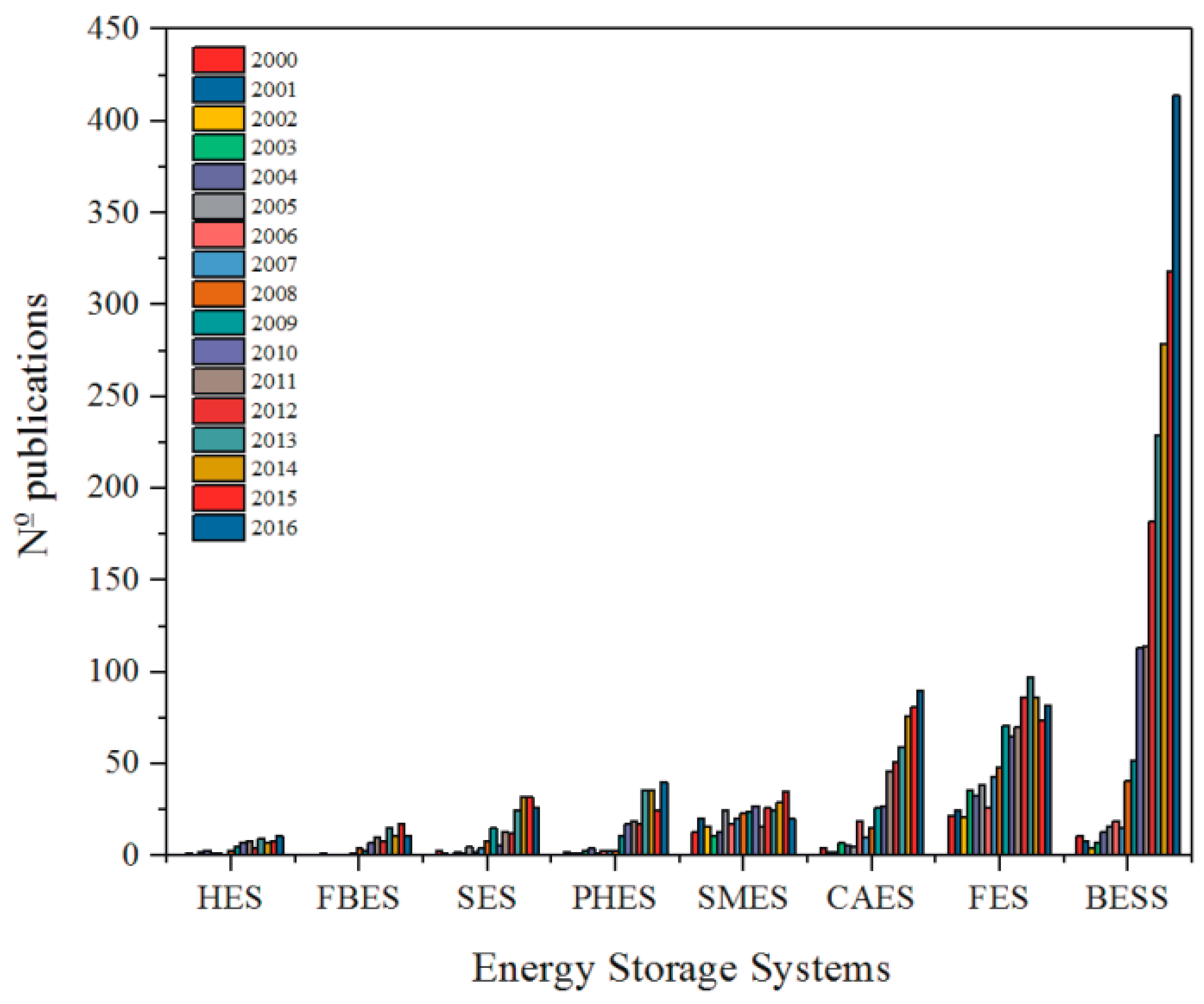
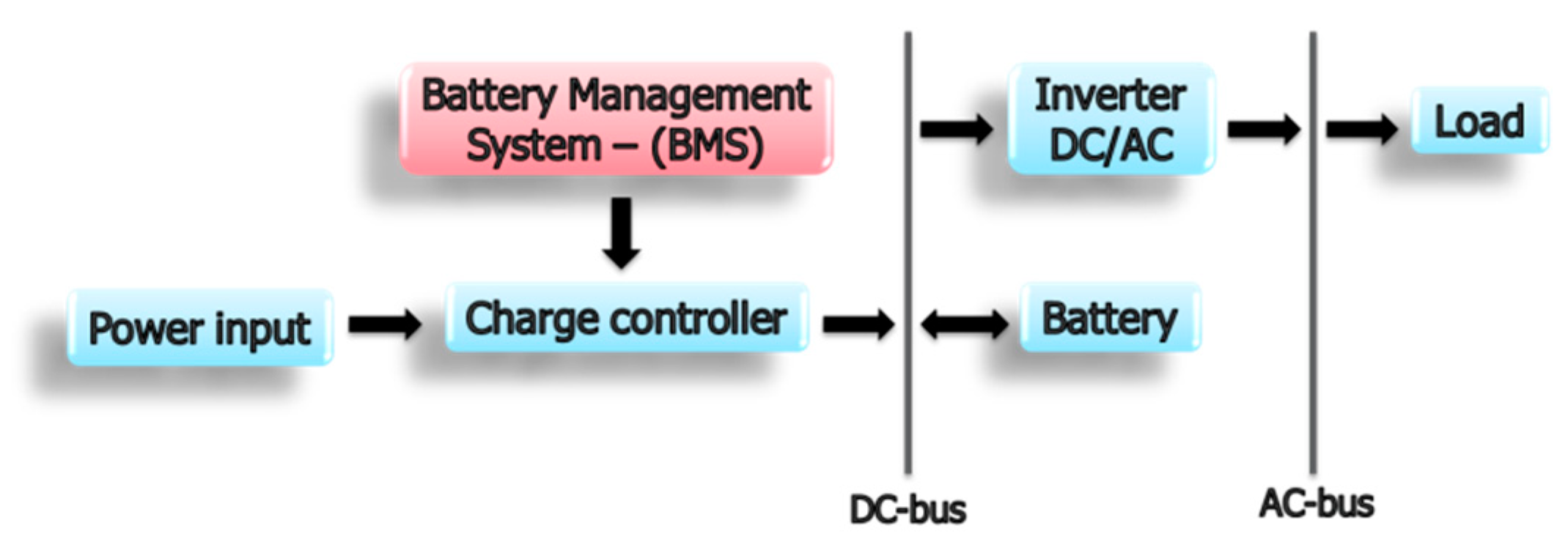

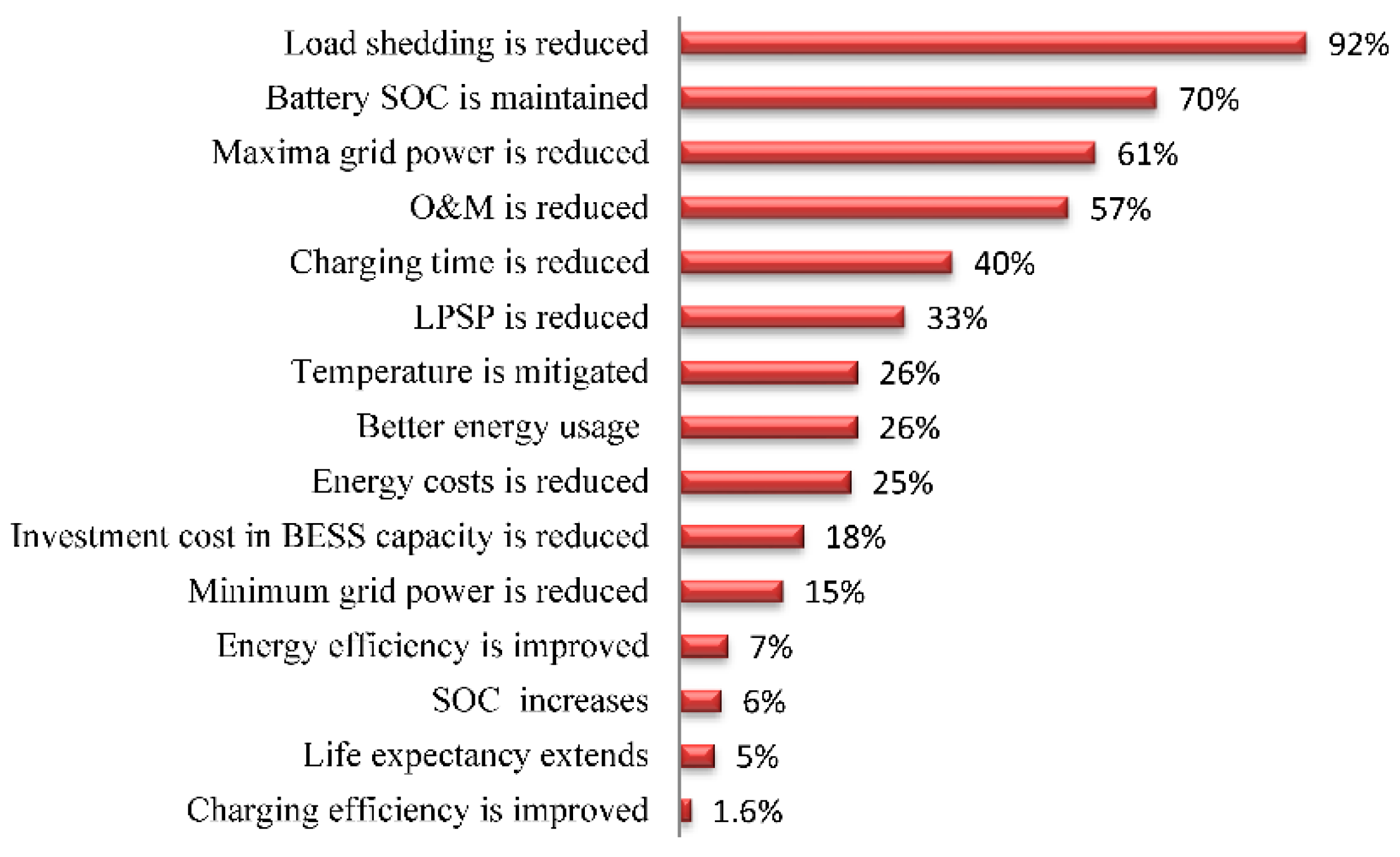
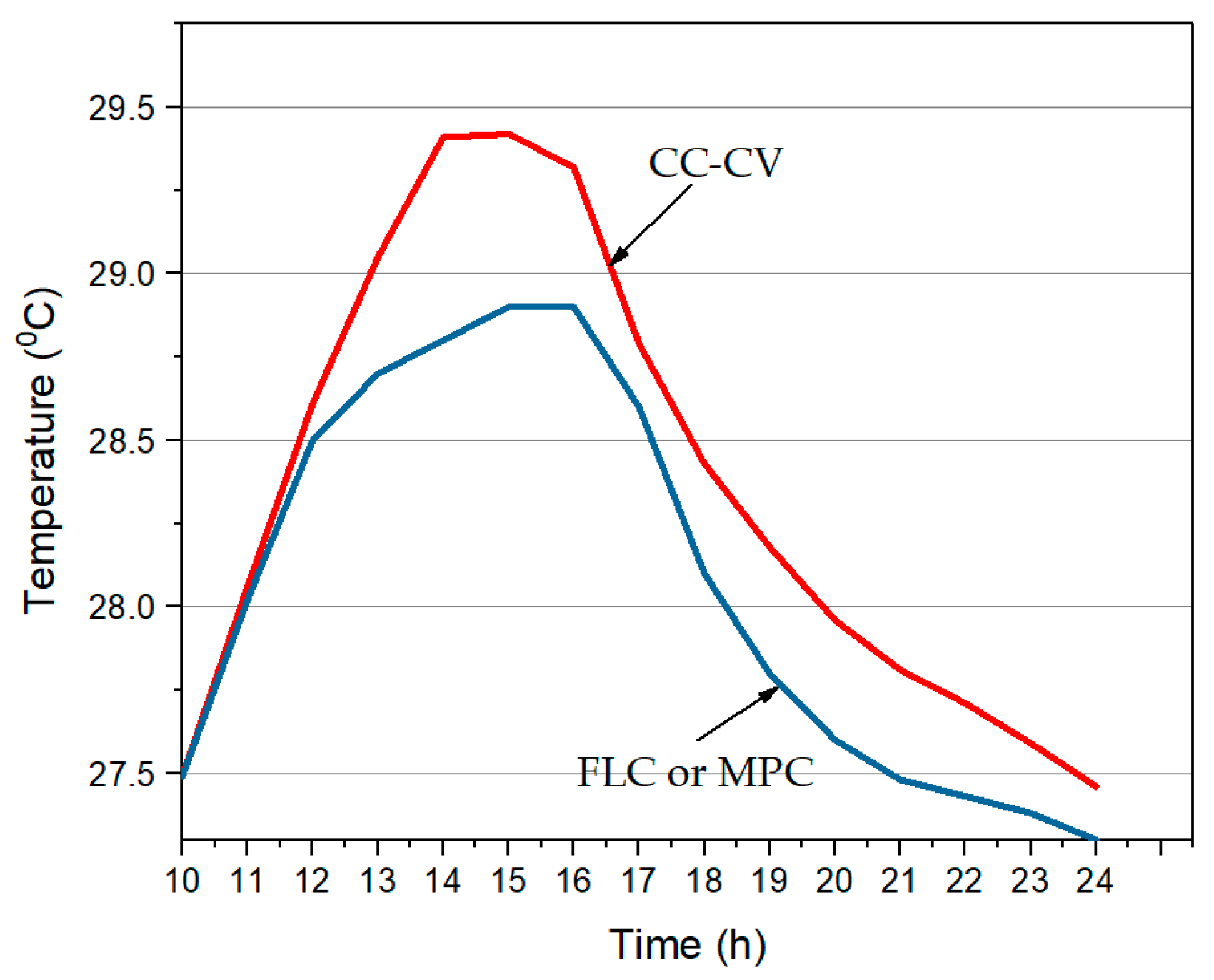
| Technology | Pb-Acid | Li-Ion | Ni–Cd | Na–S | PSB | VRB |
|---|---|---|---|---|---|---|
| Capital cost ($/kWh) | 50–400 | 600–2500 | 400–2400 | 200–600 | 150–1000 | 150–1000 |
| Efficiency (%) | 70–90 | 75–95 | 60–70 | 71–90 | 60–75 | 65–85 |
| Operating temperature (°C) | −5 to 40 | −30 to 60 | −40 to 50 | 325 | 0 to 40 | 0 to 40 |
| Depth of discharge (DOD, %) | 60–70 | 80 | 100 | 60–100 | 75 | 75 |
| Energy density (Wh/kg) | 30–50 | 75–250 | 50–75 | 100–240 | >400 | 10–75 |
| Life cycles (cycles) | 500–2000 | 1000–10,000 | 1000–3500 | 2000–5000 | 100–13,000 | 12,000+ |
| Lifetime (years) | 3–15 | 5–20 | 5–20 | 5–20 | 10–15 | 5–20 |
| Availability (%) | 99.99 | 97+ | 99+ | Up to 99.98 | ***** | 96–99 |
| Technological maturity level (1: lower to 5: higher) | 5 | 4 | 4 | 4 | ***** | 3 |
| Response time (ms) | Fast | Fast | Fast | Fast | ***** | ***** |
| Capacity (MW) | 0.001–50 | 0.001–50 | 0–50 | 0.05–30 | 0.005–120 | 0.005–1.5 |
© 2018 by the authors. Licensee MDPI, Basel, Switzerland. This article is an open access article distributed under the terms and conditions of the Creative Commons Attribution (CC BY) license (http://creativecommons.org/licenses/by/4.0/).
Share and Cite
Banguero, E.; Correcher, A.; Pérez-Navarro, Á.; Morant, F.; Aristizabal, A. A Review on Battery Charging and Discharging Control Strategies: Application to Renewable Energy Systems. Energies 2018, 11, 1021. https://doi.org/10.3390/en11041021
Banguero E, Correcher A, Pérez-Navarro Á, Morant F, Aristizabal A. A Review on Battery Charging and Discharging Control Strategies: Application to Renewable Energy Systems. Energies. 2018; 11(4):1021. https://doi.org/10.3390/en11041021
Chicago/Turabian StyleBanguero, Edison, Antonio Correcher, Ángel Pérez-Navarro, Francisco Morant, and Andrés Aristizabal. 2018. "A Review on Battery Charging and Discharging Control Strategies: Application to Renewable Energy Systems" Energies 11, no. 4: 1021. https://doi.org/10.3390/en11041021
APA StyleBanguero, E., Correcher, A., Pérez-Navarro, Á., Morant, F., & Aristizabal, A. (2018). A Review on Battery Charging and Discharging Control Strategies: Application to Renewable Energy Systems. Energies, 11(4), 1021. https://doi.org/10.3390/en11041021





